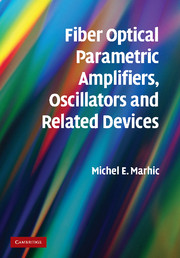Book contents
- Frontmatter
- Contents
- Acknowledgments
- 1 Introduction
- 2 Properties of single-mode optical fibers
- 3 Scalar OPA theory
- 4 Vector OPA theory
- 5 The optical gain spectrum
- 6 The nonlinear Schrödinger equation
- 7 Pulsed-pump OPAs
- 8 OPO theory
- 9 Quantum noise figure of fiber OPAs
- 10 Pump requirements
- 11 Performance results
- 12 Potential applications of fiber OPAs and OPOs
- 13 Nonlinear crosstalk in fiber OPAs
- 14 Distributed parametric amplification
- 15 Prospects for future developments
- Appendices
- Index
- References
4 - Vector OPA theory
Published online by Cambridge University Press: 23 March 2010
- Frontmatter
- Contents
- Acknowledgments
- 1 Introduction
- 2 Properties of single-mode optical fibers
- 3 Scalar OPA theory
- 4 Vector OPA theory
- 5 The optical gain spectrum
- 6 The nonlinear Schrödinger equation
- 7 Pulsed-pump OPAs
- 8 OPO theory
- 9 Quantum noise figure of fiber OPAs
- 10 Pump requirements
- 11 Performance results
- 12 Potential applications of fiber OPAs and OPOs
- 13 Nonlinear crosstalk in fiber OPAs
- 14 Distributed parametric amplification
- 15 Prospects for future developments
- Appendices
- Index
- References
Summary
Introduction
In Chapter 3 we derived optical parametric amplifier (OPA) equations under the assumption that all four waves involved were in the same state of linear polarization along the fiber length. This led to a relatively simple set of four scalar equations. By solving these equations we then obtained a set of solutions that can provide a good preliminary understanding of the performance of fiber OPAs.
In this chapter we enlarge the class of OPAs by considering more general possibilities for the SOPs of the waves. We begin by developing a vector formalism for light propagating in arbitrary SOPs in isotropic fibers. We apply it to circularly polarized (CP) and linearly polarized (LP) waves; since some of the waves may have identical or orthogonal SOPs, this leads to a class of 12 basic types of OPA. We then turn to fibers with constant birefringence, such as polarization-maintaining fibers (PMFs), and explore the impact of the birefringence on the gain spectrum. Finally we consider the typical case of fibers that have weak birefringence with random longitudinal variations, and we investigate the effect of these variations.
Isotropic fibers
The treatment here follows the general approach introduced in [1].
Classification of basic OPA types
We make the following basic assumptions. (i) The fiber is lossless. (ii) The fiber does not exhibit birefringence, either linear or circular. (iii) The fiber operates in the fundamental mode at all frequencies.
- Type
- Chapter
- Information
- Publisher: Cambridge University PressPrint publication year: 2007
References
- 1
- Cited by



